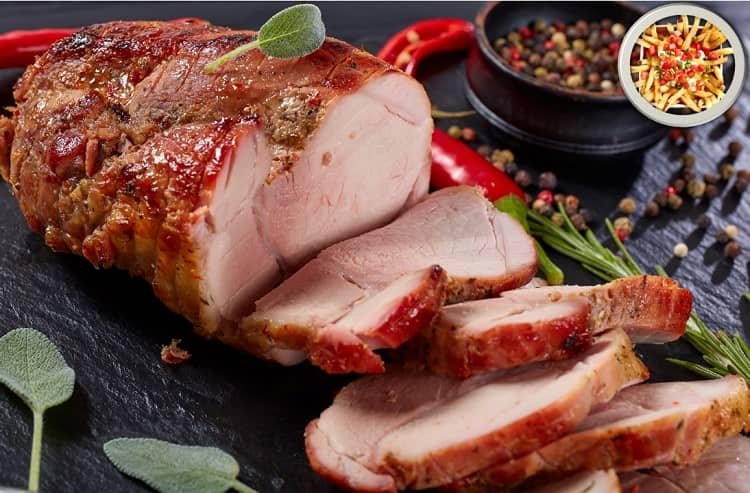Bringing the Butcher’s Craft Into Your Kitchen
There’s something deeply satisfying about crafting your own smoked Canadian bacon at home. It’s leaner than American bacon, loaded with smoky-sweet flavor, and perfect for everything from breakfast sandwiches to gourmet pizzas. But the real magic happens when you control the entire process—from the brine to the smoke—resulting in a finished product that far surpasses the store-bought version in flavor, quality, and nutrition.
Whether you’re a barbecue hobbyist, a DIY food enthusiast, or simply someone who appreciates fine cured meats, this blog is your comprehensive guide to making smoked Canadian bacon right in your own kitchen.
What Is Canadian Bacon? And Why It’s Not “Bacon” in Canada
Despite its name, Canadian bacon is actually more similar to ham than American belly bacon. In Canada, this cut is often referred to as “back bacon.” Here’s how it differs from its American counterpart:
| Feature | Canadian Bacon | American Bacon |
|---|---|---|
| Cut | Pork loin (lean) | Pork belly (fatty) |
| Flavor | Mild, slightly sweet | Salty, rich, smoky |
| Texture | Firm, meaty | Crispy or chewy |
| Usage | Breakfast, pizza, sandwiches | Breakfast, burgers, wraps |
Why Make Smoked Canadian Bacon at Home?
1. Superior Flavor Control
Want it sweeter, smokier, spicier, or infused with garlic? When you make it yourself, the seasoning is all up to you.
2. Cleaner Ingredients
Homemade Canadian bacon means no artificial preservatives, nitrates, fillers, or excess sodium.
3. Cost Efficiency
Buying pork loin in bulk and curing it at home can cost less than half the price of pre-packaged back bacon.
4. Culinary Bragging Rights
You’ll impress family, friends, or weekend brunch guests with your artisan-level bacon—custom smoked and sliced by hand.
Ingredients You’ll Need: The Foundation of Flavor
Meat:
- 1 whole pork loin (4–5 pounds), trimmed of silver skin and excess fat
Basic Wet Cure Brine (for every 5 pounds of pork):
- 1 gallon cold, filtered water
- 1 cup kosher salt
- ½ cup brown sugar (light or dark)
- 1 tbsp Prague Powder #1 (pink curing salt)
- 1 tbsp garlic powder
- 1 tbsp onion powder
- 1 tbsp cracked black pepper
- Optional: ¼ cup real maple syrup or honey (for sweetness)
Pro Tip: Avoid iodized table salt as it can affect the flavor and clarity of the brine.
Essential Tools for Success
- Large food-safe container or sealable plastic bag
- Measuring cups and spoons
- Smoker (pellet, charcoal, electric, or offset)
- Meat thermometer (instant-read or probe)
- Sharp slicing knife
- Wire rack and sheet pan
- Plastic wrap or vacuum sealer
Step-by-Step Process: Making Smoked Canadian Bacon from Scratch
Step 1: Trim the Pork Loin
- Use a sharp knife to remove silver skin and visible fat.
- Trim uneven ends for a uniform log-shaped piece (even smoking = better results).
Step 2: Prepare the Brine
- In a large container, dissolve salt, sugar, and pink curing salt in cold water.
- Add remaining spices, stir until fully incorporated.
- For deeper flavor penetration, inject some brine into the loin with a meat injector.
Step 3: Brine (Cure) the Meat
- Fully submerge the pork loin in the brine.
- Cover and refrigerate for 5–7 days, turning once daily to ensure even curing.
Rule of Thumb: Cure for at least 2 days per inch of thickness.
Step 4: Rinse and Soak
- After curing, remove the loin and rinse thoroughly under cold water.
- Soak in clean water for 60 minutes, changing the water halfway to reduce salt levels.
Step 5: Dry and Form a Pellicle
- Pat the loin dry and place it uncovered on a wire rack in the fridge for 12–24 hours.
- A sticky outer layer (pellicle) will form—this helps the smoke adhere better and creates that classic outer texture.
Step 6: Smoke It Low and Slow
- Preheat your smoker to 180°F–200°F (82°C–93°C).
- Use mild wood like apple, maple, or cherry. Avoid overly aggressive woods like mesquite.
- Smoke the loin until it reaches an internal temp of 145°F (63°C)—usually 2–3 hours depending on thickness.
Optional Finishing Touch: Brush with maple syrup during the last 30 minutes for a glossy, sweet glaze.
Step 7: Chill, Slice, and Store
- Let the smoked loin cool slightly, then refrigerate for at least 4 hours or overnight.
- Slice thinly across the grain using a sharp knife or meat slicer.
- Vacuum seal and freeze for longer shelf life, or keep refrigerated for up to 10 days.
Flavor Variations: Customize Your Canadian Bacon
Maple & Bourbon Glaze
Add ¼ cup bourbon and 3 tbsp maple syrup to your brine. Baste with a bourbon-maple glaze while smoking.
Garlic & Herb Infusion
Add fresh rosemary, thyme, and minced garlic to the brine. Great with oak or hickory smoke.
Sweet & Spicy
Toss in crushed red pepper flakes, cayenne, and a touch of brown sugar for bold, complex flavor.
Apple Cider Brine
Substitute half of the water in the brine with unsweetened apple cider for a fruity twist.
Canadian Bacon vs. Peameal Bacon: What’s the Difference?
Often confused with each other, here’s how these two Canadian staples differ:
| Feature | Canadian Bacon | Peameal Bacon |
|---|---|---|
| Cured | Yes | Yes |
| Smoked | Yes | No |
| Coating | None | Rolled in cornmeal |
| Cooked Before Serving | Yes (smoked) | No (must be cooked fresh) |
| Common In | USA & Canada | Mostly in Ontario, Canada |
Serving Suggestions: How to Use Your Homemade Canadian Bacon
1. Classic Eggs Benedict
Poached eggs, toasted English muffins, hollandaise sauce, and a slice of Canadian bacon = brunch perfection.
2. Canadian Bacon Breakfast Sandwich
Layer with fried egg and cheddar on a toasted brioche bun.
3. Charcuterie Boards
Slice cold and serve alongside cheeses, nuts, and dried fruits.
4. Pizza or Flatbreads
Use in place of ham or pepperoni for a leaner, smoky kick.
5. Pasta Carbonara (Canadian Style)
Use chopped Canadian bacon instead of pancetta for a smoky twist.
Canadian Breakfast – Traditional and Innovative Canada Breakfast Foods
Storage and Shelf Life
| Storage Method | Duration |
|---|---|
| Refrigerator (sealed) | Up to 10 days |
| Freezer (vacuum sealed) | 4–6 months |
| Sliced and frozen (vacuum sealed) | 3–4 months |
Nutrition Profile (per 2 oz cooked serving)
| Nutrient | Value |
|---|---|
| Calories | 90–100 kcal |
| Protein | 15–17g |
| Total Fat | 2–3g |
| Carbohydrates | 0–2g |
| Sodium | 400–600mg (varies by recipe) |
Troubleshooting & Pro Tips
Meat Tastes Too Salty?
- You may have skipped or shortened the soaking step post-brine. Next time, soak longer or use less salt.
No Smoky Flavor?
- Ensure the pellicle formed properly, and try a stronger wood or longer smoke time.
Tough Texture?
- The meat was likely overcooked. Pull it from the smoker exactly at 145°F internal temp.
Can’t Get a Pellicle?
- Let the meat air-dry longer, preferably in the fridge on a wire rack.
Frequently Asked Questions (FAQs)
Q1. Is curing salt really necessary?
Yes. Prague Powder #1 is essential for safety (prevents botulism) and helps maintain pink color and cured flavor.
Q2. Can I cold smoke Canadian bacon?
Technically yes, but it’s risky unless you have curing and cold-smoking expertise. Stick to hot smoking at safe temps.
Q3. Do I need a smoker to make this?
A smoker is ideal, but you can bake it in your oven at low temp and add liquid smoke or a smoke tube for effect.
Q4. Can I cure multiple loins at once?
Absolutely. Just multiply the brine recipe and ensure everything stays submerged.
Q5. How do I slice it evenly?
Chill or slightly freeze before slicing. A meat slicer works best, but a sharp knife will do fine for thicker cuts.
Final Thoughts: Make It Once, and You’ll Never Go Back
Creating smoked Canadian bacon at home might seem like a culinary challenge, but once you do it, you’ll be hooked for life. Not only do you get control over every step, but the final result is leaps and bounds better than anything wrapped in plastic on a grocery store shelf.
You’ll be enjoying crisp, smoky, juicy slices of bacon that you handcrafted—perfect for breakfast spreads, gourmet cooking, or just snacking cold from the fridge.
So, tie on that apron, fire up the smoker, and taste the difference of homemade Canadian bacon—made better, made by you.






